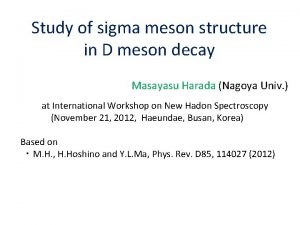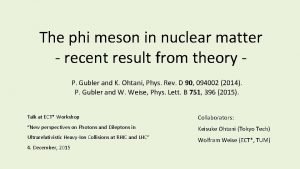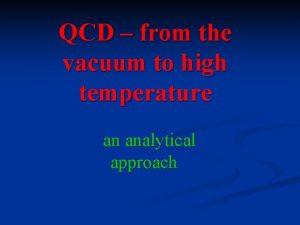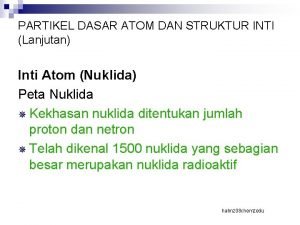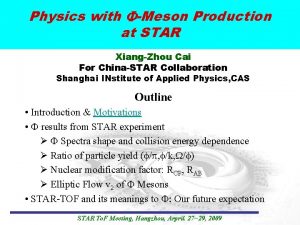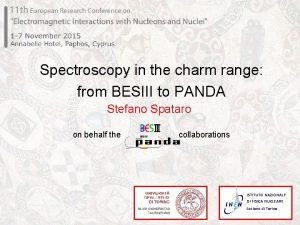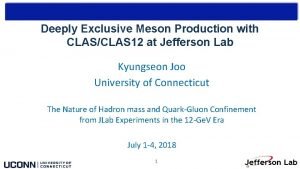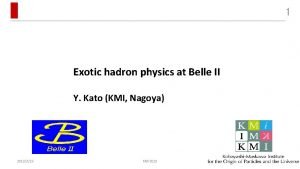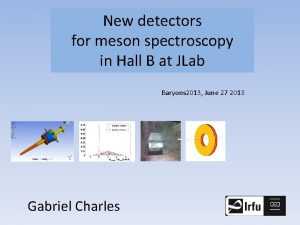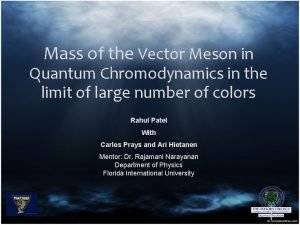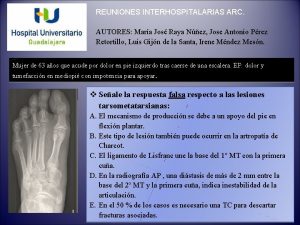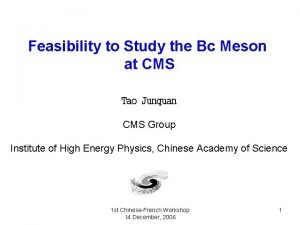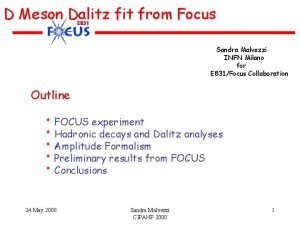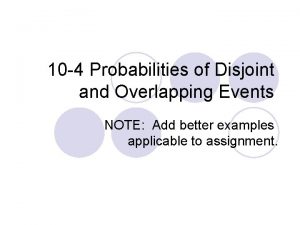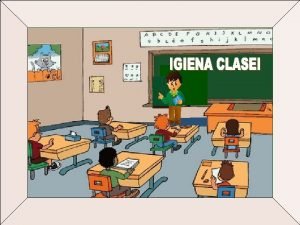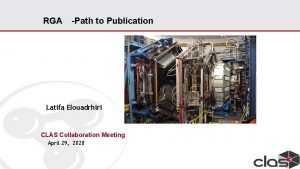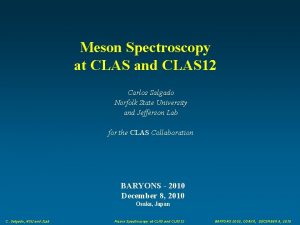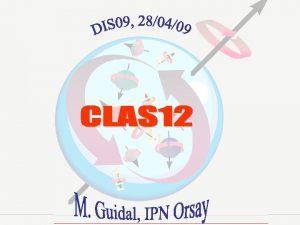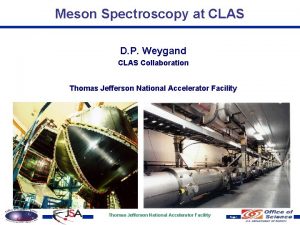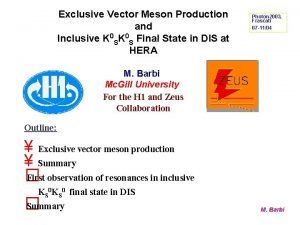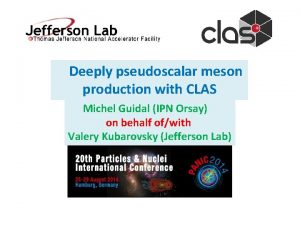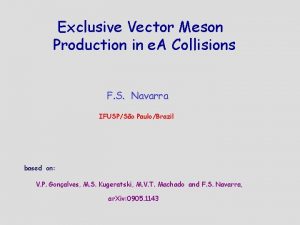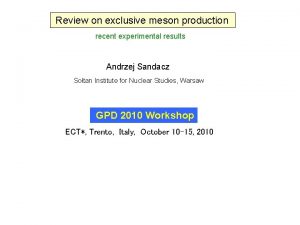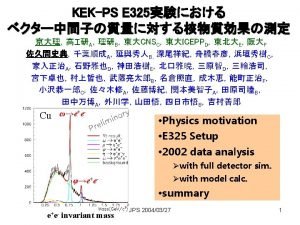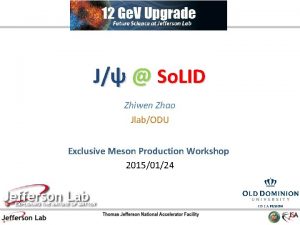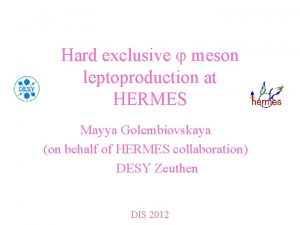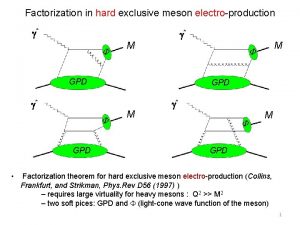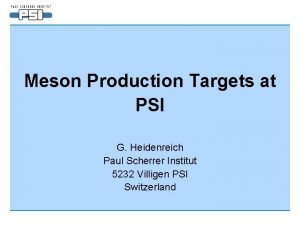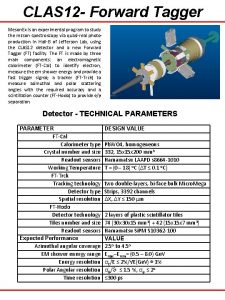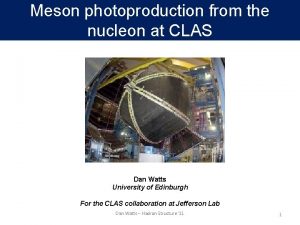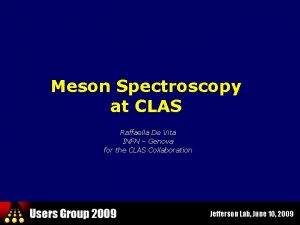Exclusive Meson Production CLAS and CLAS 11 Paul























- Slides: 23

Exclusive Meson Production CLAS and CLAS 11 Paul Stoler-RPI

Goals of the DVMP Experimental Program Measure electroproduction of mesons above the resonance region (W > 2 Ge. V) over a large range of of Q 2 and t in the valence quark region of x

Explore transition from “hadronic” to “partonic” regime by testing model-independent features of reaction mechanisms Obtain mapping of nucleon structure in terms of quarks and gluons through application of phenomenological models (e. g. handbag).

Physics Issues Q 2 : Size of interaction region probed by virtual photon. t: Size of interaction region for emission of meson (DVMP) or photon(DVCS) low Q 2 high -t low Q 2 low -t high Q 2 high -t

Kinematic regions in electroproduction W>2 Ge. V High Q 2 Low -t Complement DVCS experiment. Unique access to spin dependent GPDs. W>2 Ge. V Low Q 2 High -t New form factors related to 1/x moments of GPDs W>2 Ge. V High Q 2 High -t Region never before accessed. Small initial configurations and small reaction size. W<2 Ge. V High Q 2 - High -t Resonance form factors.

Vector Pseudoscalar CLAS 6: lots of data. CLAS 12: Exp. # **** CLAS 6: lots of data. CLAS 12: New proposal being prepared for PAC 38 Strangeness No published CLAS 6 papers Large program planned for CLAS 12 by RICH group. .

Scaling of t slopes with Q 2 Gluon GPD

Dynamical Mass of Light Dressed Quarks DSE and LQCD Q 2 ➙ ~ 11 12 Ge. V 2 LQCD per dressed quark Pq p ➙ 1. 15 Ge. V

ep e’ p Cross sections vs t for different Q 2 ~ 0 e. Bt Q 2 (Ge. V 2) ___ 1. 75 ___ 2. 25 ___. 75 2 B~1 Ge. V-2 0. 2 fm ___ 3. 25 ___ 4. 75 ___ 5. 25 P. Stoler, Ohio, Jan 8, 2008 rho t slope small for low Q 2 –larger for large Q 2 large size to small size eta same large for all Q 2, therefore always small size ? ? ? New experiment extend t Q 2

Structure Functions GM Laget Regge model -t

GPD’s Flavor separation Access to polarized GPDs

Pseudoscaler Meson Production (Analog to WACS) ds/dsdtd. Q 2 (nb/Ge. V 6) (Huang and Kroll) -t (Ge. V 2)

Factorization of short range hard and long range soft only works for longitudinal photons.

Large angle (high -t) relatively small Q 2 ds/dsdtd. Q 2 (nb/Ge. V 6) (Analog to WACS where handbag works very well) (Huang and Kroll) -t (Ge. V 2)

Vector mesons Separate Long Through angular distriburion of the decay products in helicity frame.

Gluon and Quark GPDs

world data VGG+``D term”

Compare f an

GPD n ≈ 2. 0


New PAC 38 Proposal (August 2011) Vector Meson Deep Virtual Exclusive Electroproduction • Kinematics Q 2 from 3 – 10 Ge. V 2 • t from. 5 to 10 Gev 2 W from 2 -4 Ge. V 2 • Run simultaneously with ******* • Simulations for f and r are beginning • (Isolating K’s over entire kinematic range. )

Conclusion • We have a very rich program of pseudoscalar meson production which will provide unique information about the transition between soft long-range phenomena and hard short range. • It will serve as a complementary component of the deep exclusive program at CLAS 12, providing unique access to axial/spin distributions in the nucleon. • The goal would then be to get a picture of the quark momentum and spin distributions of the nucleons.

Experiments Already Completed Electroproduction of p π +π - at 0. 2<0. 6, 1. 3<1. 57 Ge. V Fedotov PRC 79, 015204 (2009) Measurement of semi-inclusive p+ electroproduction off the proton Osipenko PRD 80, 032004 (2009) Exclusive ρ 0 electroproduction on the proton at CLAS, S. Morrow, EPJ A 39, 5 (2009) Electroproduction of f(1020) mesons at 1. 4<=Q 2<=3. 8 Ge. V^2 measured with the CLAS spectrometer Santoro PRC 78, 025210 (2008) Measurement of ep-->epp 0 beam spin asymmetries above the resonance region De Masi PRC 77, 042201 (R) (2008) Separated Structure Functions for the Exclusive Electroproduction of K+ L and K+ S 0 Final States Ambrozewicz Phys. Rev. C 75: 045203 Deeply virtual and exclusive electroproduction of omega mesons Morand EPJA 24, 445 (2005) Exclusive rho 0 meson electroproduction from hydrogen at CLAS Hadjidakis PLB 605, 256 (2005) First Measurement of Transferred Polarization in the Exclusive e(pol)p -> e'K+Lambda (pol) Reaction Carman PRL 90, 131804 (2003) Measurement of ep -> e'p p+ p- and baryon resonance analysis Ripani PRL 91, 022002, (2003) Exclusive electroproduction of F mesons at 4. 2 Ge. V Lukashin PRC 63, 065205 (2001); Err. 64, 059901 (2001) Electroproduction of the L(1520) Hyperon Barrow PRC 64, 044601 (2001) Measurement of Single and Double Spin Asymmetries in Deep Inelastic Pion Electroproduction with Longitudinally Polarized Target Avakian PRL 105, 262002 (2010)
 Mutually exclusive vs non mutually exclusive
Mutually exclusive vs non mutually exclusive Pengertian production dalam multimedia
Pengertian production dalam multimedia Sigma meson
Sigma meson Phi meson
Phi meson Meson valves
Meson valves Partikel meson
Partikel meson Lucas 10 30 37
Lucas 10 30 37 K star meson
K star meson B meson decay
B meson decay Jefferson lab
Jefferson lab B meson decay
B meson decay Meson
Meson Meson
Meson Irene mendez meson
Irene mendez meson Bc meson
Bc meson Sandra malvezzi
Sandra malvezzi Inclusive exclusive math
Inclusive exclusive math Mutually exclusive and exhaustive events
Mutually exclusive and exhaustive events Mutually exclusive events examples
Mutually exclusive events examples P(a/b) formula
P(a/b) formula Probability of disjoint and overlapping events
Probability of disjoint and overlapping events Uf prehealth advising
Uf prehealth advising Si plusat si vargat apa-ndata a zvantat
Si plusat si vargat apa-ndata a zvantat Clas collaboration meeting
Clas collaboration meeting


